 |
|
Pectin hydrogels have interesting properties for pharmaceutical and food industries; nevertheless, pH sensitivity is one major drawback. The aim of this research was to evaluate the effect of methacrylate grafting on the structure of low methoxy citrus pectin and its gelling ability and pH sensitivity. Gellation of pectin 3 % (w/v) dispersions with 10 mM CaCl2 were photocrosslinked with 10 % (w/v) Irgacure™ 2959 (265 nm UV). Bovine serum albumin was incorporated into gels by diffusion and diffusion coefficient was calculated. FT-IR spectra (1737, 1617 and 949 cm-1) suggested an efficient grafting. At pH 1.5, pectin (p) gels had higher diffusion coefficient (5.92x10-6±4x10-9 cm2·s-1) than methacrylic grafted pectin (MP) gels (2.18x10-9±2x10-10 cm2·s-1). At neutral pH, P gels dissolved; but MP gels displayed stability reflected in high diffusion coefficient (2.68x10-6±4x10-8 cm2·s-1). The MP gels had larger pores and were 2.46 times stronger than P gels. Grafting pectins with methacrylic groups and combining photocrosslinking and ionic gelation allowed to get MP gels that overcome acidic pH sensitivity and improved the controlled release capacity.
Keywords: pectin, photo-crosslinking, gelation, diffusion, pH sensitivity.
|
|
 |

